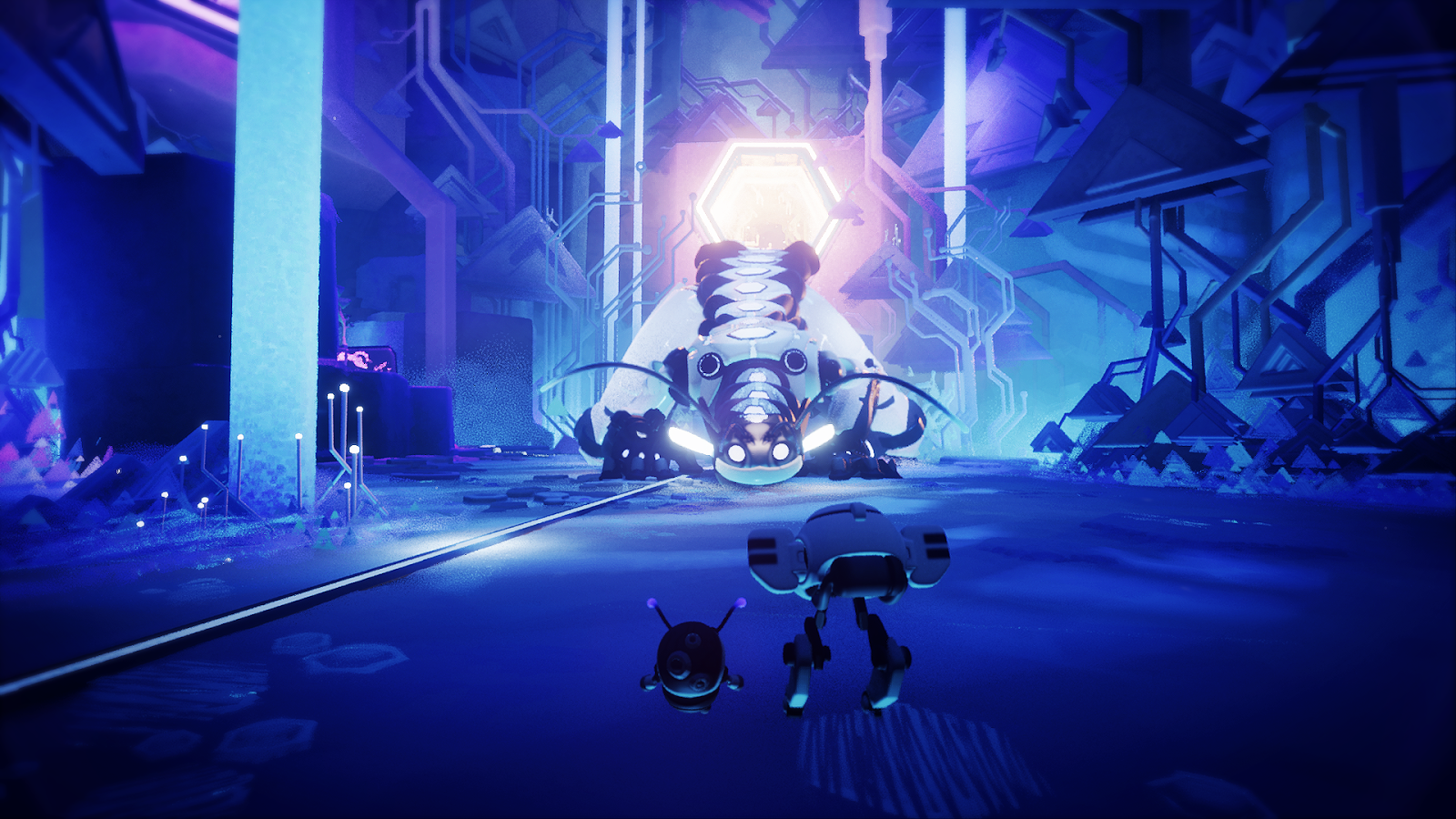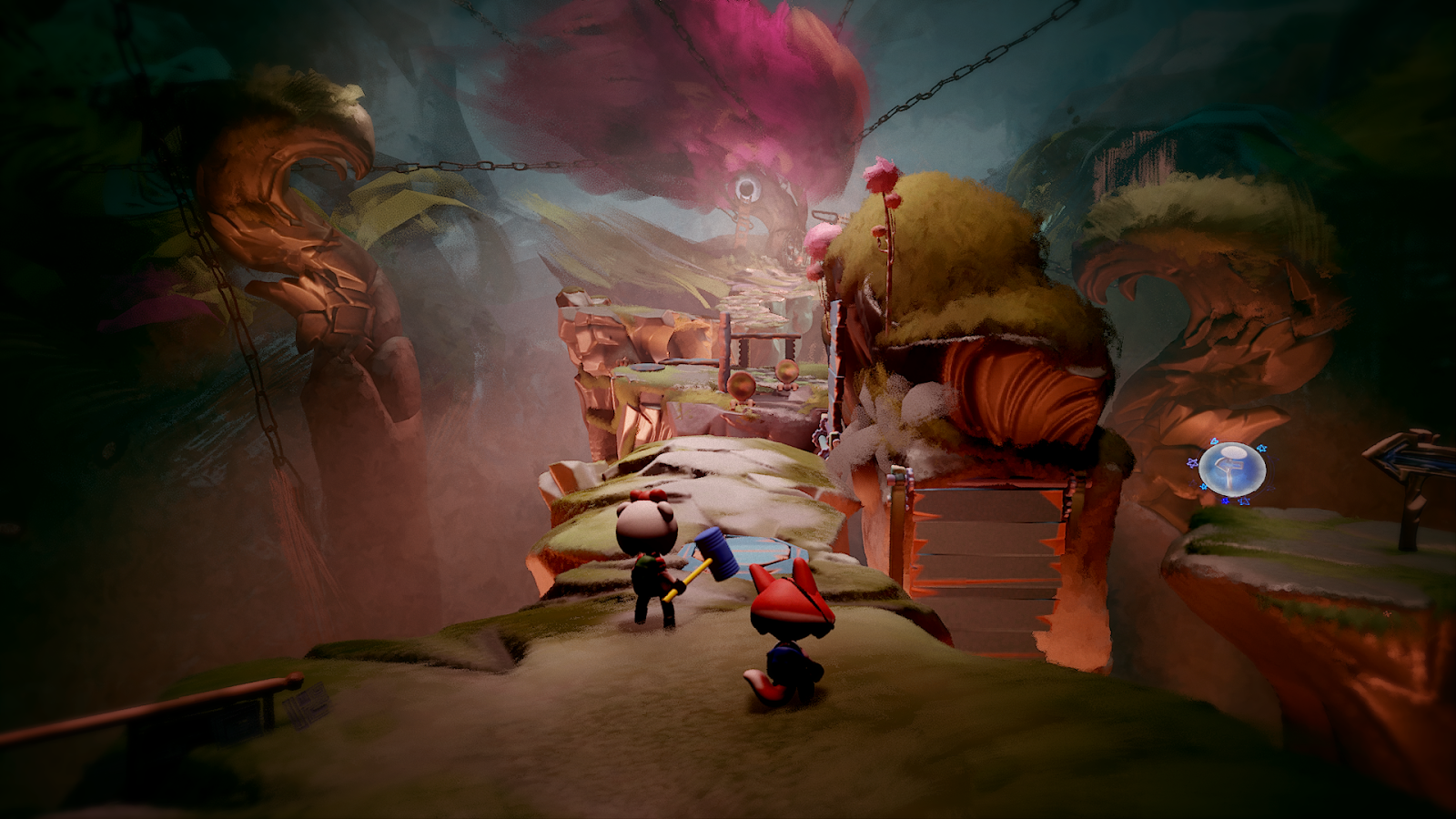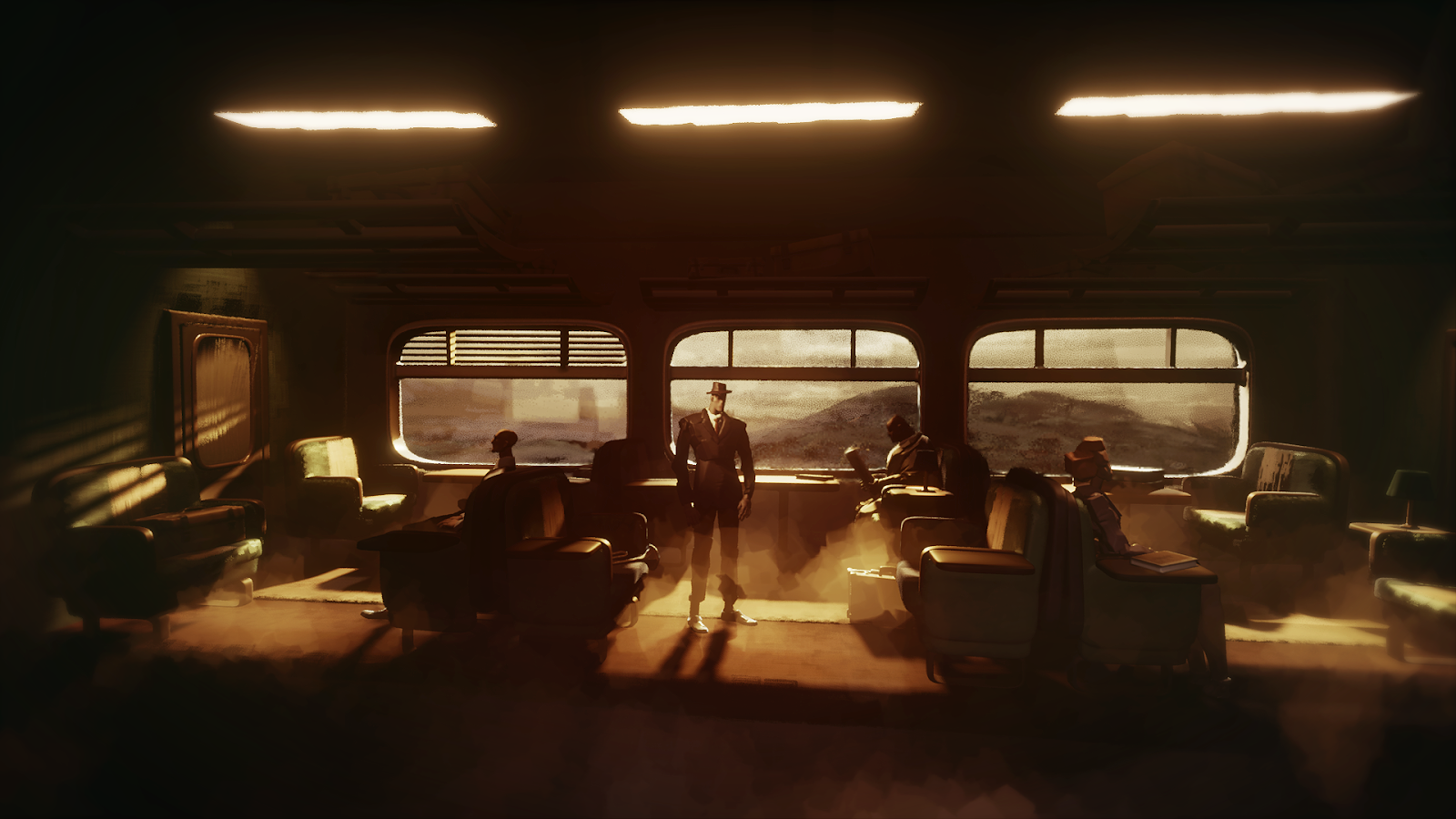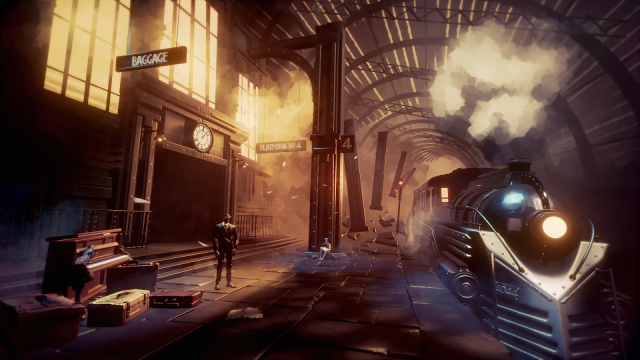Dreams is one of the most exciting upcoming releases for the PlayStation 4 next year. It’s also very difficult to explain what it is.
It builds on developer Media Molecule’s “play, create, share” ethos, but unlike the studio’s previous work in the LittleBigPlanet series, it is not a cute co-op platformer that lets you create your own levels.
Its ambition is much bigger.
Instead of putting together little levels made from charming handmade-looking blocks and shapes and stickers provided by the developer, it lets you create… well, anything. Anything at all. A neon city, a desert wasteland, a moving T-Rex skeleton, a solar system where all the planets are cat faces.
You can make something as small as a 3D painting of a vase of flowers, or as big as an entire adventure game with its own characters, dialogue and musical score. Then you can upload it for other people to play, or to use in their own Dreams creations.
After spending a day with Dreams and the people who made it in Guildford, England, I’ve come to think of it as a god game, though not in the traditional, micromanagement sense: it’s about creating things, then bestowing life upon them and sending them out into the world.
Like LittleBigPlanet, Dreams has a single-player mode, a run of levels created by Media Molecule that serve the dual purpose of entertaining you and showing you what’s possible with its creative tools.
There are three stories being told here: a whimsical 3D platformer in which a fox and a bear try to save their pet dragon; a noir point-and-click adventure; and a sci-fi puzzle platformer starring a cute little robot who looks a little like one of the trademark PlayStation PlayRoom robots.
These three stories could not be more tonally or aesthetically different.
In one scene, you’re playing through a fairytale with huge-headed characters and high-pitched voices, jumping across platforms and walloping non-threatening monsters with a hammer. The next you’re helping a gangly jazz musician climb out of a cello case and find his way through a deserted train station, under gravelly voice-over. In the third, you’re standing on platforms to activate circuits that help a little robot escape a science-fiction cave.
These three stories alternate for the length of the single-player mode, and though impressive in range, it is difficult to parse on first impressions. You can tell that these threads will somehow come together, but from the first three levels it’s impossible to see how. My guess is that there’s some Inception-style dream-within-a-dream narrative ploy going on.
Dreams does not really make sense until you see the creative tools that were used to make it.
Those tools are given to every player. Unlike LittleBigPlanet, or indeed any other game that invites you to create your own levels, Dreams does not limit you to collaging together textures, items, music, characters et cetera created for you by the developer. It lets you create every single one of those things yourself, if you want.
Once I realised that every tiny detail in the single-player levels was made with these tools, from the suitcases on a train platform to the flying dragon with its emphatic facial expressions – and then I realised that I could make something like that, too – I began to understand the full scope of Dreams, and what it is trying to make possible.
Dreams gives you a way to sketch out things that are in your head and turn them into whatever you want: short game levels, scenes, pieces of music, 3D art. It is a virtual space that lets you experiment creatively in any way you might like.
A virtual synthesiser lets you play with music, whilst a 3D art studio lets you create characters or environments by pulling and poking and painting shapes, and a logic system lets you connect things together, triggering events in a level or just hooking up a switch to a door.
All of this is seamless, and you can move from composing to painting to animating to playing with a button press. It’s more Minecraft than LittleBigPlanet, though it goes further than either in giving you creative power. Whether you are interested in making music, creating characters, animation, level design, programming or art, Dreams gives you a fun way to do it without having to put hundreds of hours into learning how to use a piece of professional software like Maya 3D or Unity or GarageBand.

The Big Idea behind Dreams is to democratize digital creativity, to allow you, or your eight-year-old, to experiment with game creation as easily as a professional. The results will vary massively, of course, but Dreams is designed such that pretty much anything you make will look alright and be functional, even if it’s a bit rubbish. You can spend a half-hour doodling around or spend a few weeks with some friends putting together something really complex.
Couch co-op and online co-op will let teams of people come together to make something; imagine teaming up with an artist or musician from the other end of the world to make a fantasy adventure.
If all of that sounds exhausting and intimidating to you, then Dreams can also be enjoyed as a playlist of other people’s creations (and Media Molecule’s). As someone who doodles in sketchbooks, fiddles with guitars and loved crafts as a kid but has long since failed to make time for creative endeavours – and someone who never made a level in LittleBigPlanet – I find the allure of Dreams‘ creation tools irresistible.
Spending a day at Media Molecule’s headquarters in Guildford, I watched several of the studio’s staff play around with Dreams. Kareem Ettouney, the studio’s effusive art director, used two motion-sensitive Move controllers to manipulate and transform shapes in a virtual space, putting them together to sketch out a mountain range. He made sketching in 3D look effortless.
A button press let him meld shapes together and play with the look of them, sharpening or softening the edges, cutting bits out to define a ridge. Within 10 minutes he created a desert scene, placed a sun in the sky, added colour and changed the lighting. He then filled in some water, and with another stroke of the Move controller the water animated, flowing into a pool. He painted in some grass that then moved as if in a gentle wind.
At any point, another press of a button dropped a character into this world he created out of nothing and let you walk around in it. It really is something to behold.
Within a half-hour, Ettouney had constructed buildings and created an enormous, angular, weird neon city beside the mountains. It’s so huge that the little character is totally lost in it, so he zoomed in to a player’s-eye view to create pathways and routes through, making it more playable.
I did not understand how the PS4 was not on fire at this point. I kept expecting a little white flag to pop out of the disc tray.
The creative tools are easy to use, but also go very deep. Music composition, for instance, lets you either mess around with the controller and your voice to put together something that sounds decent, or dive right in and edit each individual note on a chart.
Another impressive demonstration: A Media Molecule level designer started from scratch, this time with a DualShock controller, and put together a simple platforming level from assets that other people have made, in the space of about twenty minutes. It was a woodland scene, with waterfalls and moving platforms, a cute little animal character, even a boss at the end. It was a heck of a lot more impressive than anything you could make in Unity in 20 minutes.

Everything made in Dreams has an impressionistic look, even though the idea is to let you create anything. You’re never going to make anything in Dreams that looks as good as Uncharted, obviously, but you can make something looks professional and is completely playable. Or, if you like, you can just make cool furniture and upload it for other people to use.
Once Dreams is unleashed on millions of players, it’s going to go in directions that nobody expected.
A single well-made object that you worked hard on might end up appearing in hundreds of other people’s worlds. You could follow the same piece of music through the web of uploaded dreams, and see how different people have used it. Hopping around through different uploaded creations works like a Spotify playlist; a web of tags, themes and player ratings will chain different levels together, meaning you could spend an hour dream-surfing three times a week and see completely new things each time.
Dreams isn’t a conventional game with a start and an end point, really. It’s definitely a game, with levels and a substantial single-player mode and a potentially infinite selection of player-created content to play.
It’s also a way to create and share things, to express yourself.
If you struggle to see the point in getting out some watercolours on a Sunday afternoon or playing with Plasticine with your kids or your nieces, Dreams might be a hard sell. But I think a lot of us have some latent creativity within, searching for an outlet. And even if you’re not driven to create dreams yourself, looking at what other people make is going to be fascinating.
There are going to be some tricky things to navigate for Dreams‘ creators in the early days of release, which currently isn’t any more specific than “sometime in 2018”. Handling copyrighted and inappropriately sexual creations will be one of them. Although Media Molecule wants players to be able to make whatever they want, Sony is presumably not going to want such content uploaded for sharing; age gating is one option, but intensive moderation is going to have to be involved no matter what.

Can you do anything with your Dreams creations outside of the game? Not yet, but there are plans. Media Molecule intends to let people 3D-print their creations, though it’s not yet clear how. VR implementation is planned, but there’s no detail on when or in what capacity that might happen. It is theoretically possible for a Dreams creation to exist as a separate game in itself. Creative director Mark Healey, one of Media Molecule’s founders, told me that his personal dream is for some kid to make something in Dreams that Sony then releases as a game.
I can say without hyperbole that I have never seen anything remotely like Dreams in the 12 years that I’ve been visiting game studios.
It has the potential to inspire millions in the art of game creation, in a way that goes much deeper than LittleBigPlanet or even Minecraft. On a less grandiose, but perhaps just as important level, it’s a way for any player to reconnect with their creativity, on as big or small a scale as they like.

Comments
13 responses to “Dreams For PS4 Is Hard To Explain, But It Looks Brilliant”
This sounds really exciting, I hope they can pull it off.
I’d like to prototype ideas for art installations.
Does it have VR support?
Literally from the article:
“VR implementation is planned, but there’s no detail on when or in what capacity that might happen. “
Thanks, reading at work means you miss stuff sometimes.
Don’t feel bad, I read the whole article and also missed that bit.
Also at work.
Third last paragraph. Not yet, but it’s planned.
Thanks, somehow I skipped a line when reading the last paragraph, caught the 3D printing part, missed the VR.
I melded the two lines and read it thus
I need more sleep.
That’s what I was wondering too. Could be incredible in VR.
So it’s Second Life but oriented more towards a single player experience rather than a social space?
It will be interesting to see how it goes. I’ve seen a number of connected player created game worlds systems (I don’t even know what to call them) get announced but either never eventuate or fade into obscurity. Maybe the MM name will get this one off the ground.
I don’t remember second life having anything like this toolset.
Klik ‘N Play 2: Electric Boogaloo?
I adored LBP, the later instalments weren’t able to capture everything that made the first so good despite expanding the tools so much.
One of the craziest designs I ever saw was a working game of Tic Tac Toe, even MM had to admit they had no idea how it was achieved.
What about the bloke who made a working calculator in LBP? Pretty nuts!
If anyone’s interested vv
https://m.youtube.com/watch?v=Vv4segUgctQ